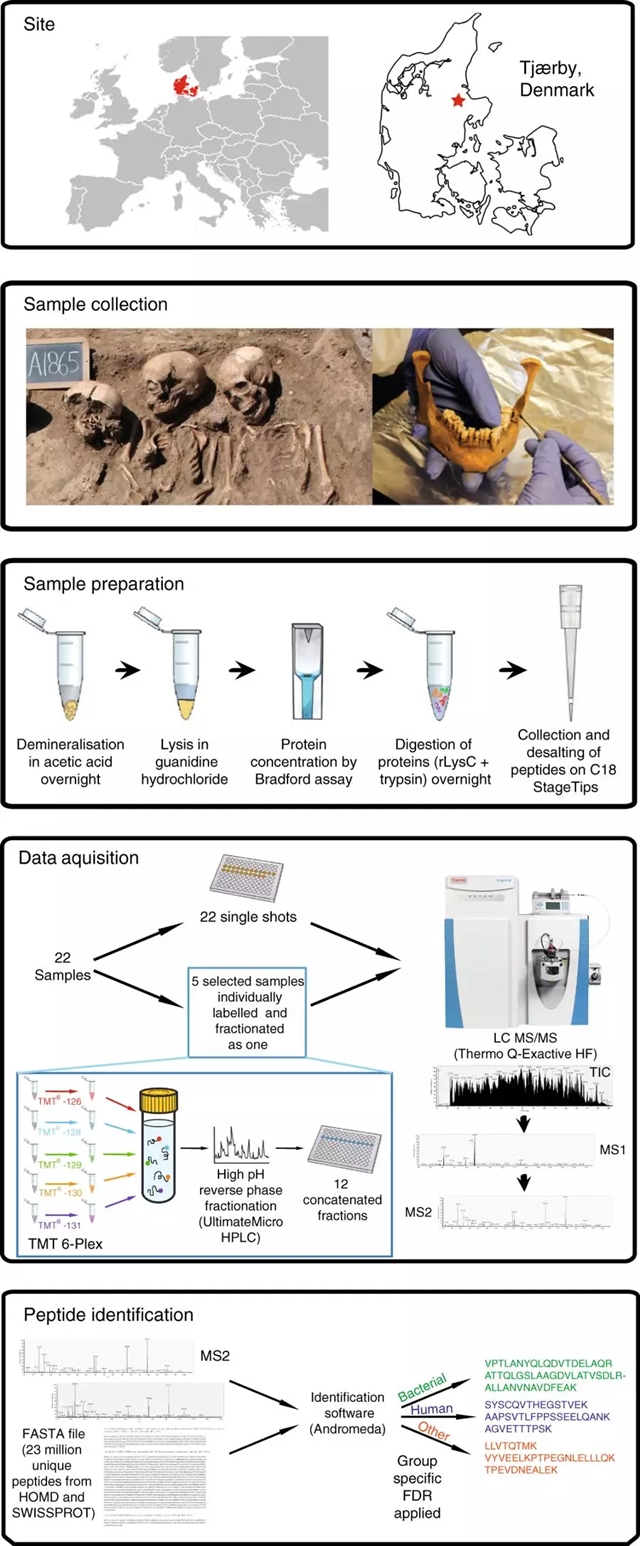论文标题:Quantitative metaproteomics of medieval dental calculus reveals individual oral health status
期刊:Nature Communications
作者:Rosa R. Jersie-Christensen, Liam T. Lanigan, David Lyon, Meaghan Mackie, Daniel Belstrøm, Christian D. Kelstrup, Anna K. Fotakis, Eske Willerslev, Niels Lynnerup, Lars J. Jensen, Enrico Cappellini, Jesper V. Olsen
发表时间:2018/11/20
数字识别码: 10.1038/s41467-018-07148-3
原文链接:https://www.nature.com/articles/s41467-018-07148-3?utm_source=other&utm_medium=other&utm_content=null&utm_campaign=JRCN_2_RL_sciencenet_article_10.1038_s41467-018-07148-3&error=cookies_not_supported&code=bd3df033-99a5-4270-9d79-6aa80dc3ead0
微信链接:https://mp.weixin.qq.com/s/y5-IlWGUdnNW8QR_omx0gw
《自然-通讯》本周发表的一篇论文Quantitative metaproteomics of medieval dental calculus reveals individual oral health status对21名中世纪丹麦居民的牙菌斑进行了分析。研究显示,特定的蛋白特征可以区分健康个体和更易罹患口腔疾病的个体。这些差异无法用传统方式观察到,作者认为这表明他们的方法对于理解口腔卫生的历史状况具有一定价值。

图1:上图显示了中世纪样本的位置、样本制备和数据分析流程。图源:Jersie-Christensen等
牙菌斑中含有各式各样的分子,有些来自人体,有些来自细菌和食物。这种分子组成在健康和疾病个体之间存在差异, 被认为像指纹一样独特。
丹麦哥本哈根大学的Jesper Olsen、Enrico Cappellini及同事通过一种名为宏蛋白质组学的方法,对丹麦Tjærby墓地考古发掘出的21个个体的牙菌斑进行了分析,鉴定和量化其中的人体、细菌和膳食蛋白质,这些个体的年代可以追溯到公元1100-1450年左右。
他们将这些样本与 7名在世的健康参与者的样本进行了对比。作者通过分析发现,第一组中世纪样本具有显著的病原菌,而第二组与在世个体的健康口腔菌群具有更大相似性。这些蛋白特征还指出了古代和现代牙菌斑的一般差异,这或许能反映出生活方式和卫生习惯的转变。

图2:细菌属在样本组之间的差异表达。图源:Jersie-Christensen 等
作者最后指出,这一结果表明宏蛋白质组学有助于对古代人群的人体健康实现更全面的重建。
摘要:The composition of ancient oral microbiomes has recently become accessible owing to advanced biomolecular methods such as metagenomics and metaproteomics, but the utility of metaproteomics for such analyses is less explored. Here, we use quantitative metaproteomics to characterize the dental calculus associated with the remains of 21 humans retrieved during the archeological excavation of the medieval (ca. 1100–1450 CE) cemetery of Tjærby, Denmark. We identify 3671 protein groups, covering 220 bacterial species and 81 genera across all medieval samples. The metaproteome profiles of bacterial and human proteins suggest two distinct groups of archeological remains corresponding to health-predisposed and oral disease-susceptible individuals, which is supported by comparison to the calculus metaproteomes of healthy living individuals. Notably, the groupings identified by metaproteomics are not apparent from the bioarchaeological analysis, illustrating that quantitative metaproteomics has the potential to provide additional levels of molecular information about the oral health status of individuals from archeological contexts.
阅读论文全文请访问:https://www.nature.com/articles/s41467-018-07148-3?utm_source=other&utm_medium=other&utm_content=null&utm_campaign=JRCN_2_RL_sciencenet_article_10.1038_s41467-018-07148-3&error=cookies_not_supported&code=bd3df033-99a5-4270-9d79-6aa80dc3ead0
期刊介绍:Nature Communications (https://www.nature.com/ncomms/) is an open access journal that publishes high-quality research from all areas of the natural sciences. Papers published by the journal represent important advances of significance to specialists within each field.
The 2017 journal metrics for Nature Communications are as follows:
•2-year impact factor: 12.353
•5-year impact factor: 13.691
•Immediacy index: 1.829
•Eigenfactor® score: 0.92656
•Article Influence Score: 5.684
•2-year Median: 8
(来源:科学网)
特别声明:本文转载仅仅是出于传播信息的需要,并不意味着代表本网站观点或证实其内容的真实性;如其他媒体、网站或个人从本网站转载使用,须保留本网站注明的“来源”,并自负版权等法律责任;作者如果不希望被转载或者联系转载稿费等事宜,请与我们接洽。